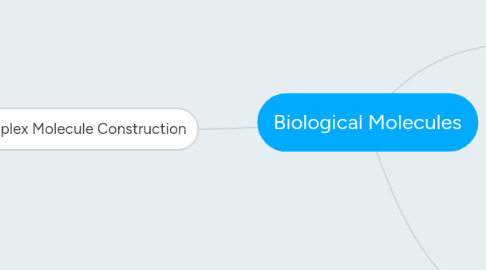
1. Aspects
1.1. Carbon skeleton and some nitrogen
1.2. Contained by organisms
2. Principle Molecules
2.1. Carbohydrate
2.1.1. Composition
2.1.1.1. Carbon: hydrogen: oxygen 1:2:1
2.1.1.2. Carbon rings
2.1.2. Classification
2.1.2.1. One sugar is a monosaccride
2.1.2.2. Two bond sugars is a disaccride
2.1.2.3. Two or more sugars is a polysaccride
2.1.3. Aspects
2.1.3.1. Energy source
2.1.3.2. Soluble in water
2.1.4. Important Sugars
2.1.4.1. Monosaccrides
2.1.4.1.1. Glucose
2.1.4.1.2. Fructose
2.1.4.1.3. Galactose
2.1.4.1.4. Ribose
2.1.4.1.5. Deoxyribose
2.1.4.2. Polysaccrides
2.1.4.2.1. Sucrose
2.1.4.2.2. Lactose
2.1.4.2.3. Maltose
2.1.4.2.4. Starch
2.1.4.2.5. Glycogen
2.1.4.2.6. Cellulose
2.2. Lipid
2.2.1. Composition
2.2.1.1. Nonpolar end composed of hydrogen and carbon
2.2.1.2. Polar "head"
2.2.2. Classification
2.2.2.1. Oils
2.2.2.1.1. Only carbon, hydrogen, carbon
2.2.2.1.2. Triglycerides
2.2.2.1.3. Chemical energy
2.2.2.1.4. Unsaturated
2.2.2.2. Fats
2.2.2.2.1. Only carbon, hydrogen, carbon
2.2.2.2.2. Triglycerides
2.2.2.2.3. Chemical energy
2.2.2.2.4. Saturated
2.2.2.3. Waxes
2.2.2.3.1. Only carbon, hydrogen, carbon
2.2.2.3.2. Not a food source
2.2.2.3.3. Highly saturated
2.2.2.3.4. Creates waterproof barriers
2.2.3. Aspects
2.2.3.1. Contain the water soluble head and nonpolar tail
2.2.4. Important Lipids
2.2.4.1. Phospholipids
2.2.4.1.1. Only two tails
2.2.4.1.2. Creates semi-permeable membranes in cells
2.2.4.2. Steroids
2.2.4.2.1. Four carbon rings
2.2.4.2.2. Important in endocrine system
2.3. Protein
2.3.1. Composition
2.3.1.1. Chains of amino acids (polypeptides)
2.3.1.1.1. Carbon surrounded by four different functional groups
2.3.1.1.2. Use dehydration synthesis to connect amino acids
2.3.1.2. Disulfide bridges
2.3.1.2.1. link polypeptide chains
2.3.1.2.2. Causes protein to bend or fold
2.3.1.3. Central Dogma
2.3.1.3.1. Primary structure
2.3.1.3.2. Secondary Structure
2.3.1.3.3. Teritary Structure
2.3.1.3.4. Quarternary Structures
2.3.2. Aspects
2.3.2.1. Used structurally
2.3.2.2. Used functionally (ex. antibodies)
2.3.2.3. Used for development
2.3.3. Important Proteins
2.3.3.1. Enzymes
2.3.3.1.1. Guide chemical reactions
2.3.4. Denaturing
2.3.4.1. When a protein cannot perform its function it is denatured
2.4. Nucleic Acid
2.4.1. Composition
2.4.1.1. Phosphate group + sugar + base
2.4.1.1.1. Sugar is either ribose or deoxyribose
2.4.2. Classficiation
2.4.2.1. Sub-units are nucleotides
2.4.3. Aspects
2.4.3.1. Bound together by phosphate to sugar to other sub-units
2.4.4. Nucleic Acids
2.4.4.1. DNA
2.4.4.1.1. Contain genetic information
2.4.4.2. RNA
2.4.4.2.1. Takes place in DNA transcription and translation
2.4.4.3. Cyclic nucleotides
2.4.4.3.1. intracellular communicator
2.4.4.3.2. molecule to molecule within cell
2.4.4.4. Adenosine triphosphate (ATP)
2.4.4.4.1. Energy carriers
2.4.4.4.2. Produced during photosynthesis and cellular respiration
2.4.4.5. Coenzymes
2.4.4.5.1. Nucleotide combined with vitamin
3. Complex Molecule Construction
3.1. Monomers
3.1.1. Single Unit
3.1.2. Connected to make polymers
3.2. Monomer Connecting/Disconnecting
3.2.1. Dehydration Synthesis
3.2.1.1. Hydrogen ion removed from one monomer
3.2.1.1.1. Hydroxl group removed from other monomer
3.2.1.2. Hydroxl and hydrogen ion leave as water
3.2.1.3. Creates a covalent bond
3.2.2. Hydrolysis
3.2.2.1. Water is added to two monomers
3.2.2.1.1. Splits polymer to two monomers
3.2.2.2. Hydrogen ion added to one, hydroxl to other
3.3. Functional Groups
3.3.1. Groups of atoms arranged for reactivity in molecule
3.3.1.1. Attached to carbon
3.3.2. Examples
3.3.2.1. Hydrogen
3.3.2.2. Hydroxl
3.3.2.3. Carboxyl
3.3.2.4. Amino
3.3.2.5. Phosphate
3.3.2.6. Methyl
